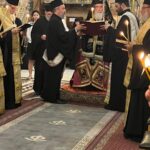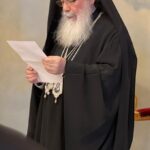THE FEAST OF THE RETURN OF SAINT SABBA’S RELICS
On Thursday, October 13/26, 2023, the Patriarchate celebrated the commemoration of the return of the relics of our Holy Father among the Saints Sabba the Sanctified.
On this day the Church, and especially the Church of Jerusalem commemorates that on October 13/26, 1965, the relics of Saint Sabba the Sanctified was returned from Venice, where it had been transferred by the Crusaders. The sacred and incorrupt relics of Saint Sabba was given to the Church it belongs by the Roman Catholic Church, after the removal of the anathemas and the beginning of the dialogue with the Orthodox Church in 1964.
For the return of the relics the blessed Metropolitans Germanos of Petra and Basileios of Caesarea, the Spiritual Father of Saint Sabba Monastery Archimandrite Seraphim and the current Metropolitan Kyriakos of Nazareth, who was a Deacon then, went to Venice. After the welcoming reception of the Saint’s relics at Jaffa Gate, it was displayed for veneration at the Church of the Holy Sepulchre for a week and then transferred to the Monastery Saint Sabba founded, to remain there for the blessing and healing of the Monastery Fathers and the pilgrims.
This event was celebrated this year with an all-night vigil at the Monastery, presided over by His Eminence Metropolitan Joachim of Helenoupolis, with the co-celebration of the Spiritual Father of the Monastery Archimandrite Eudokimos, the Hegoumen of the Monastery of the Shepherds and Beit Jala Archimandrite Ignatios, at the chanting of Hierodeacon Simeon. The Vigil was attended by members of the flock from the occupied territories of Bethlehem, Beit Jala and Beit Sahour.
His Beatitude the Patriarch of Jerusalem Theophilos did not attend the Vigil due to the ongoing hostilities, however, He sent the following Sermon:
“Light is sown for the righteous, and gladness for the upright in heart. Rejoice in the Lord, ye righteous; and give thanks at the remembrance of his holiness” (Ps. 97, 11-12), the psalmist proclaims.
Beloved Fathers and brethren in Christ,
Reverend Christians
Today the Holy Church of Jerusalem rends glory and thanksgiving to the Holy Triune God, on the commemoration of the return of Saint Sabba’s relics at his Lavra.
The honour given to the holy relics of the Saints by the Holy Orthodox and Apostolic Church is an action of faith and confession to the Resurrection of our Lord and Saviour Jesus Christ. And this is, because according to Saint Paul, “But if there be no resurrection of the dead, then is Christ not risen: And if Christ be not risen, then is our preaching vain, and your faith is also vain” (1 Cor. 15, 13-14).
According to the testimony of the Holy Bible, the Saints’ relics are distinguished for their grace which stems from the power of the Holy Spirit. Let us hear Saint Chrysostom saying: “For it is possible for the one who comes here in faith to gain great benefits; because not only the bodies but also the reliquaries of the Saints themselves are full of spiritual grace. If this happened on the occasion of the prophet Elisha and the dead person who touched the reliquary broke the bonds of death and returned to life, how much more now, that grace is more abundant, now that the power of the Holy Spirit is more, the one who touches the reliquary in faith can receive great power from it. For this reason, God left the Saints’ relics with us, wanting to guide us to the same zeal as theirs, and offer us a safe harbour and comfort for the evil things that always happen to us”.
The fact that the Saint’s relics are carriers of the grace of the Holy Spirit’s power is steadfast proof that the Saints’ dead bodies testify to Christ’s resurrection, as Saint John Damascene says: “They have become vessels of God and sacred dwelling places; “as God hath said, I will dwell in them, and walk in them; and I will be their God” (2 Cor. 6,16). For they are “righteous people who are protected by God and will never suffer torment” (Wisdom of Solomon 3,1). And it is written in the Bible, that the death of the Saints is sleep rather than death; for they toiled forever and shall live until the end; “Precious in the sight of the Lord is the death of his saints” (Ps. 116,15). What is more honourable than being in the hands of God? For God is life and light and those who are in the hands of God exist in life and light”.
This is precisely what the Resurrection of Christ is, namely the light and life of God. “I am the light of the world: he that followeth me shall not walk in darkness, but shall have the light of life” (John 8,12), the Lord says.
Our Holy Father Sabba followed Christ, walking in His light, that is why he received the light of life, of the resurrected Christ, and received the incorruption of his earthly body. The incorrupt relics of our Sanctified Father Sabba is an endless source gushing forth fragrance and healing power of the Holy Spirit.
Behold, therefore, my dear brethren, the meaning of the holy relics and the reason why our Holy Orthodox Church holds special honour for the relics of its saints and righteous. Let us hear again Saint John Damascene: “Through the mind, God dwelt in the bodies of the righteous, as Saint Paul says: “What? know ye not that your body is the temple of the Holy Ghost which is in you” (1 Cor. 6,19), “the Lord is that Spirit” (2 Cor. 3,17). How can we not then honour the living souls of the temples of God, the living dwelling places of God? For they stood in boldness before God, yet living”.
Our God-bearing Father Sabba became such a living temple of God, whose “death is sleep rather than death”, as the hymnographer says: “Since thou wast temperate, guileless, silent and simple and meek, past what is common for men, thou O Father, didst truly appear as immaterial while in the flesh, and an all-worthy house of God; and in thy sympathy, thou dost pass on to us of the gifts that come from Him to thee” (Minaion, December 5, Matins, praises, Troparion 3).
We, my dear brethren, who honour the return of the relics of our Holy Father Sabba the Sanctified, let us entreat him and the Most blessed Theotokos saying: beseech Christ to grant our region and the world peace and great mercy. Amen. Many happy and peaceful returns.”
The Fathers returned to Jerusalem via the Holy Monastery of Abba Theodosios according to the custom.
From Secretariat-General


